One-Pot Synthesis of the MoVOx Mixed Oxide Nanobelts and Its Photoelectric Properties in the Broadband Light Spectrum Range Exhibiting Self-Powered Characteristics
Abstract
1. Introduction
2. Results and Discussion
3. Materials and Methods
3.1. Raw Materials
3.2. Synthesis of MoVOx Mixed Oxide with One Pot
3.3. Characterization with SEM, UV-Vis-NIR Spectrum, and XRD
3.4. Measurement of the Optoelectronic Signal of MoVOx Mixed Oxide in the Wide Spectral Range
4. Conclusions
Author Contributions
Funding
Institutional Review Board Statement
Informed Consent Statement
Data Availability Statement
Acknowledgments
Conflicts of Interest
References
- Soundharaya, J.; Raksha, A.; Rajni, K.S.; Senthilkumar, N.; Eswaramoorthy, N.; Raguram, T. Construction of Cu-doped α-MoO3 nanostructures and their application as counter electrode in dye-sensitized solar cells. Mater. Lett. 2024, 359, 135773. [Google Scholar] [CrossRef]
- Milani, E.A.; Piralaee, M.; Raeyani, D.; Asgari, A. High-performance semi-transparent organic solar cells for window applications using MoO3/Ag/MoO3 transparent anodes. Sol. Energy Mater. Sol. Cells 2024, 276, 113066. [Google Scholar] [CrossRef]
- Şakar, B.C.; Yıldırım, F.; Aydoğan, Ş. Highly stable, self-powered UV-Vis-NIR broadband isotype photodetector based on Ti-doped amorphous MoO3. Sens. Actuators A Phys. 2024, 370, 115216. [Google Scholar] [CrossRef]
- Yadav, A.; Khan, A.; Kumar, A.; Khanuja, M.; Pathi, P.; Gupta, G. Highly responsive MoS2/MoO3 heterojunction based broadband photodetector. Opt. Mater. 2024, 157, 116227. [Google Scholar] [CrossRef]
- Subramaniyan, S.; Govindasamy, M.; Sakkarapani, S.; Kuo, C. Exploration of CeO2 decorated on MoO3 as a potential electrode for high performance hybrid supercapacitors. J. Alloys Compd. 2025, 1013, 178518. [Google Scholar] [CrossRef]
- Modi, K.H.; Pataniya, P.M.; Bhadu, G.; Sumesh, C.K. Self-supported SnS/MoO3 electrocatalyst for supercapacitor and hydrogen evolution reaction. J. Energy Storage 2024, 99, 113475. [Google Scholar] [CrossRef]
- Dabir, M.P.; Masoudpanah, S.M.; Mamizadeh, M. Ultrathin needle-like NiMoO4/MoO3 heterostructure for supercapacitor and overall water splitting applications. J. Energy Storage 2024, 82, 110542. [Google Scholar] [CrossRef]
- Sun, Y.; Li, T.; Liu, X.; Han, Y.; Liu, Y.; Zada, A.; Deng, W.; Yuan, Z.; Dang, A. Modulating oxygen vacancies in MXene/MoO3-x smart fiber by defect engineering for ultrahigh volumetric energy density supercapacitors and wearable SERS sensors. Chem. Eng. J. 2024, 494, 152911. [Google Scholar] [CrossRef]
- Shaheen, N.; Zulfiqar, S.; El Sayed, M.E.; Samir, A.; Shahid, M.; Warsi, M.F.; Cochran, E.W. Evaluation of energy storage mechanism and development of nanoarchitecture in 1D WS2/MoO3/MXene composite for supercapacitor applications. J. Alloys Compd. 2025, 1010, 178072. [Google Scholar] [CrossRef]
- Song, Y.Z.; Liu, Z.X.; Huang, Y.A. Synthesis of MnMoO4/α-MoO3 composite materials for supercapacitor. Inorg. Chem. Commun. 2024, 170, 113481. [Google Scholar] [CrossRef]
- Yue, X.; Zhang, J.; Chen, D.; Xu, X.; Wu, H.; Zhou, Y.; Liang, Z. Multifunctional α-MoO3 Nanobelt Interlayer with the Capacity Compensation Effect for High-Energy Lithium-Sulfur Batteries. ACS Appl. Mater. Interfaces 2023, 15, 13064–13072. [Google Scholar] [CrossRef]
- Wei, K.; Qiu, J.; Zhao, Y.; Ma, S.; Wei, Y.; Li, H.; Zeng, C.; Cui, Y. Tunable oxygen vacancies in MoO3 lattice with improved electrochemical performance for Li-ion battery thin film cathode. Ceram. Int. 2023, 49, 21729–21736. [Google Scholar] [CrossRef]
- Wu, Y.; Liu, W.; Zhang, Z.; Zheng, Y.; Fu, X.; Lu, J.; Cheng, S.; Su, J.; Gao, Y. Defect-Rich MoO3 Nanobelts for ultrafast and wide-temperature proton battery. Energy Storage Mater. 2023, 61, 102849. [Google Scholar] [CrossRef]
- Qin, J.; Sun, B.; Mao, S.; Yang, Y.; Liu, M.; Rao, Z.; Ke, C.; Zhao, Y. Improved resistive switching performance and mechanism analysis of MoO3 nanorods based memristors. Mater. Today Commun. 2023, 36, 106770. [Google Scholar] [CrossRef]
- Ma, K.; Kim, S.; Kim, H.Y.; Seo, I.; Han, S.H.; Shin, S.; Jang, H.S.; Kim, D.H. Mechanical and electrical properties of α-MoO3 belts under strain for flexible electronics applications. Appl. Surf. Sci. 2025, 681, 161512. [Google Scholar] [CrossRef]
- Li, J.; Wang, N.; Yang, X.; Li, J.; Xiong, S.; Fu, H.; An, X. Conductometric triethylamine sensor based on Pd nanoparticles modified Fe doped MoO3 porous nanobelts. Sens. Actuators B Chem. 2025, 137289. [Google Scholar] [CrossRef]
- Zhang, S.; Wang, Q.; Song, P. Design of narrow bandgap Fe2O3/MoO3 heterostructure for boosting triethylamine sensing performance. ChemPhysMater 2024, 3, 284–292. [Google Scholar] [CrossRef]
- Habashyani, S.; Budak, S.M.H.F.; Kasapoglu, A.E.; Çoban, O.; Gür, E. Electrochromic properties of undoped and Ti-doped MoO3 converted from vertical nanowall MoS2 thin films. Electrochim. Acta 2024, 498, 144638. [Google Scholar] [CrossRef]
- Vinay Kumar, E.; Harini, R.; Bhuvaneshwari, H.S.; Sushma, P.M.; Sushmitha, D.S.; Kumara Swamy, B.E.; Anitha, G.; Nagaraju, G. Facile green synthesis of Zn doped MoO3 nanoparticles and its photocatalytic and photoluminescence studies. J. Mol. Struct. 2024, 1312, 138494. [Google Scholar] [CrossRef]
- Tian, R.; Ding, Y.; Wang, Q.; Song, P. Advanced triethylamine sensor utilizing 3D microspheres of La-doped MoO3: Performance enhancement and mechanism insights. Sens. Actuators B. Chem. 2024, 412, 135817. [Google Scholar] [CrossRef]
- Khanlary, M.R.; Parhizkari, M.; Heydari, N. Structural and optical properties of 1T-MoS2/MoO3 thin films prepared by spray pyrolysis method. Phys. B Condens. Matter 2024, 680, 415837. [Google Scholar] [CrossRef]
- Nasser, R.; Zhou, H.; Li, F.; Elhouichet, H.; Song, J. Heterostructured MoO3@CoWO4 nanobelts towards high electrochemical performances via oxygen vacancies generation. J. Colloid Interface Sci. 2024, 654, 805–818. [Google Scholar] [CrossRef] [PubMed]
- Roy, D.; Das, B.K.; Riaz, S.N.; Das, D.; Sarkar, S.; Chattopadhyay, K.K. Oxygen Vacancy-Induced Band Engineering and Metal Unsaturation in MoS2-MoO3 with Spillover-Based Confined Catalysis. ACS Appl. Energy Mater. 2023, 6, 4892–4908. [Google Scholar] [CrossRef]
- Jansi, R.; Revathy, M.S.; Vinoth, S.; Kumar, A.; Isaac, R.S.R.; Deepa, N. Abdullah Al-Enizi, Mohd Ubaidullah, Bidhan Pandit, Mohd Shahazad, Manish Gupta, Improvement in ammonia gas sensing properties of La doped MoO3 thin films fabricated by nebulizer spray pyrolysis method. Opt. Mater. 2023, 145, 114464. [Google Scholar] [CrossRef]
- Naveen, M.V.; Krishnamurthy, G.; Yuvaraj, T.C.M.; Harini, R.; Manjuraj, T.; Anitha; Nagaraju, G. Enhanced photocatalytic applications of Ce-doped MoO3 nanoparticles synthesized via combustion process using Calophyllum seed powder. J. Mol. Struct. 2025, 1328, 141125. [Google Scholar] [CrossRef]
- Dumrongrojthanath, P.; Phuruangrat, A.; Thipkonglas, S.; Kuntalue, B.; Thongtem, S.; Thongtem, T. Synthesis and characterization of Ce-doped MoO3 nanobelts for using as visible-light-driven photocatalysts. Superlattices Microstruct. 2018, 120, 241–249. [Google Scholar] [CrossRef]
- Liu, Z.; Jin, Y.; Teng, F.; Hua, X.; Chen, M. An efficient Ce-doped MoO3 catalyst and its photo-thermal catalytic synergetic degradation performance for dye pollutant. Catal. Commun. 2015, 66, 42–45. [Google Scholar] [CrossRef]
- Tutel, Y.; Durukan, M.B.; Hacioglu, S.O.; Baskose, U.C.; Toppare, L.; Unalan, H.E. Cobalt-doped MoO3 thin films and dual-band electrochromic devices with excellent cyclic stability. Appl. Mater. Today 2023, 35, 101924. [Google Scholar] [CrossRef]
- Khalid, N.R.; Hasnain, M.; Ali, F.; Siddique, S.; Iqbal, T.; Rafique, M.; Imran, M.; Assiri, M.A. Green synthesized, photocatalytic Co-doped MoO3 nanospheres for wastewater treatment. Ceram. Int. 2024, 50, 9640–9649. [Google Scholar] [CrossRef]
- Benameur, N.; Chakhoum, M.A.; Boukhachem, A.; Dahamni, M.A.; Ghamnia, M.; Hacini, N.; Pireaux, J.-P.; Houssiau, L.; Ziouche, A. Investigation of some physical properties of pure and Co-doped MoO3 synthesized on glass substrates by the spray pyrolysis method. J. Electron Spectrosc. Relat. Phenom. 2019, 234, 71–79. [Google Scholar] [CrossRef]
- Yue, L.; Ma, L.; Zhao, Z.; Gong, F.; Yang, X.; Zhang, Y. Synthesis of mesoporous cobalt-doped MoO3 nanoribbons for highly selective detection of triethylamine. Mater. Lett. 2024, 377, 137552. [Google Scholar] [CrossRef]
- Gomathi, K.; Padmanathan, S.; Ali, A.M.; Rajamanickam, A.T. Construction of Ni doped MoO3 nanostructures and their application as counter electrode in dye-sensitized solar cells. Inorg. Chem. Commun. 2022, 135, 109079. [Google Scholar] [CrossRef]
- Jiang, W.; Meng, L.; Zhang, S.; Chuai, X.; Zhou, Z.; Hu, C.; Sun, P.; Liu, F.; Yan, X.; Lu, G. Design of highly sensitive and selective xylene gas sensor based on Ni-doped MoO3 nano-pompon. Sens. Actuators B Chem. 2019, 299, 126888. [Google Scholar] [CrossRef]
- Ganesh, V.; Yahia, I.S.; Algarni, H. Room-temperature ammonia gas sensor based on Ni-doped MoO3 thin film prepared by spray pyrolysis method. J. Mater. Sci. Mater. Electron. 2023, 34, 1656. [Google Scholar] [CrossRef]
- Bennie, R.B.; Joel, C.; Raj, A.N.P.; Antony, A.J.; Pillai, S.I. Electrical conductivity and electrochemical studies of Cr-doped MoO3 nanoflakes for energy storage applications. J. Solid State Electrochem. 2023, 27, 271–280. [Google Scholar] [CrossRef]
- Al-Otaibi, A.L.; Ghrib, T.; Alqahtani, M.; Alharbi, M.A.; Hamdi, R.; Massoudi, I. Structural, optical and photocatalytic studies of Zn doped MoO3 nanobelts. Chem. Phys. 2019, 525, 110410. [Google Scholar] [CrossRef]
- Pepe, Y.; Tutel, Y.; Ucar, A.D.; Cevik, E.; Karatay, A.; Unalan, H.E.; Elmali, A. Enhanced nonlinear absorption and photoluminescence properties of Zn, Fe, Cu, V and Ni doped MoO3 transition metal oxide thin films. Phys. Scr. 2024, 99, 025216. [Google Scholar] [CrossRef]
- Liu, A.; Liu, T.; Fu, H.; Yin, X.; Liu, K.; Yu, J. Enhanced performance of Zn and Co co-doped MoO3 nanosheets as gas sensor for n-butylamine. Ceram. Int. 2022, 48, 32986–32993. [Google Scholar] [CrossRef]
- Wang, J.; Zhou, Q.; Wei, Z.; Xu, L.; Zeng, W. Experimental and theoretical studies of Zn-doped MoO3 hierarchical microflower with excellent sensing performances to carbon monoxide. Ceram. Int. 2020, 46, 29222–29232. [Google Scholar] [CrossRef]
- Yang, S.; Liu, Y.; Chen, T.; Jin, W.; Yang, T.; Cao, M.; Liu, S.; Zhou, J.; Zakharova, G.S.; Chen, W. Zn doped MoO3 nanobelts and the enhanced gas sensing properties to ethanol. Appl. Surf. Sci. 2017, 393, 377–384. [Google Scholar] [CrossRef]
- Vinay Kumar, E.; Niveditha, B.S.; Sushmitha, L.; Usha, B.K.; Kumara Swamy, B.E.; Anitha; Nagaraju, G. Facile green synthesis of Cu-doped MoO3 nanoparticles and its application for the photocatalytic degradation of hazardous organic pollutants. Nano-Struct. Nano-Objects 2023, 36, 101066. [Google Scholar] [CrossRef]
- Tan, X.; Chen, X.; Guo, J.; Wang, L.; Dong, Z.; Li, X.; Yang, L.; Zhang, D.; Qian, L.; He, C. High performance and highly selective sensing of triethylamine sensors based on Cu-doped MoO3 nanobelts. J. Alloys Compd. 2024, 976, 173152. [Google Scholar] [CrossRef]
- Li, Z.; Wang, W.; Zhao, Z.; Liu, X.; Song, P. Facile synthesis and enhanced trimethylamine sensing performances of W-doped MoO3 nanobelts. Mater. Sci. Semicond. Process. 2017, 66, 33–38. [Google Scholar] [CrossRef]
- Yang, S.; Lei, G.; Tan, L.; Xu, H.; Xiong, J.; Wang, Z.; Gu, H. Fe-doped MoO3 nanoribbons for high-performance hydrogen sensor at room temperature. J. Alloys Compd. 2021, 877, 160200. [Google Scholar] [CrossRef]
- Li, H.; Wang, L.; Du, F. Controllable synthesis and formation mechanism of pure and Fe-doped h-MoO3 microrods under hydrothermal reaction conditions. CrystEngComm 2023, 25, 4089–4099. [Google Scholar] [CrossRef]
- Xian, H.; Guo, H.; Xia, J.; Chen, Q.; Luo, Y.; Song, R.; Li, T.; Traversa, E. Iron-Doped MoO3 Nanosheets for Boosting Nitrogen Fixation to Ammonia at Ambient Conditions. ACS Appl. Mater. Interfaces 2021, 13, 7142–7151. [Google Scholar] [CrossRef]
- Maurya, A.; Pradhan, N.; Yadav, M. Heteroatom doped MoO3 as efficient electrocatalyst towards hydrogen evolution reaction in acidic as well as alkaline medium. J. Electroanal. Chem. 2025, 977, 118827. [Google Scholar] [CrossRef]
- Shkir, M.; Trabelsi, A.B.G.; Alkallas, F.H.; AlFaify, S. High performance of the rare earth (Er, Gd & Pr) doped MoO3 thin films for advanced applications towards ammonia gas sensing. J. Mater. Res. Technol. 2022, 20, 4556–4565. [Google Scholar] [CrossRef]
- Chen, X.; Liu, T.; Yin, X. High response triethylamine gas sensor based on flaky W-doped MoO3. J. Ind. Eng. Chem. 2024, 129, 691–698. [Google Scholar] [CrossRef]
- Phuruangrat, A.; Cheed-Im, U.; Thongtem, T.; Thongtem, S.I. High visible light photocatalytic activity of Eu-doped MoO3 nanobelts synthesized by hydrothermal method. Mater. Lett. 2016, 172, 166–170. [Google Scholar] [CrossRef]
- Kamoun, O.; Boukhachem, A.; Amlouk, M.; Ammar, S. Physical study of Eu doped MoO3 thin films. J. Alloys Compd. 2016, 687, 595–603. [Google Scholar] [CrossRef]
- Ma, J.; Li, J.; Jiang, Z.; Zhang, R.; Wu, T.; Liu, C.; Xu, L.; Feng, Q. Hydrothermal preparation of a novel indium doped MoO3 photocatalyst with enhanced photocatalytic activity for Rhodamine B degradation. Opt. Mater. 2024, 154, 115792. [Google Scholar] [CrossRef]
- Bai, S.; Chen, C.; Zhang, D.; Luo, R.; Li, D.; Chen, A.; Liu, C. Intrinsic characteristic and mechanism in enhancing H2S sensing of Cd-doped MoO3 nanobelts. Sens. Actuators B 2014, 204, 754–762. [Google Scholar] [CrossRef]
- Boukhachem, A.; Kamoun, O.; Mrabet, C.; Mannai, C.; Zouaghi, N.; Yumak, A.; Boubaker, K.; Amlouk, M. Structural, optical, vibrational and photoluminescence studies of Sn-doped MoO3 sprayed thin films. Mater. Res. Bull. 2015, 72, 252–263. [Google Scholar] [CrossRef]
- Camacho, R.A.P.; Tian, R.; Liu, J.; Zhou, S.; Wu, A.; Huang, H. Superior lithium-ion storage of V-doped MoO3 nanosheets via plasma evaporation. Electrochim. Acta 2021, 394, 139121. [Google Scholar] [CrossRef]
- Yang, L.; Liu, J.; Cheng, F.; Zhou, S.; Xu, Q.; Yin, D.; Liu, X. V-doped MoO3 nanorods for highly selective oxidation of 5-hydroxymethylfurfural to bio-monomer 2, 5-furandicarboxylic acid. Renew. Energy 2024, 226, 120409. [Google Scholar] [CrossRef]
- Feste, P.D.; Crisci, M.; Barbon, F.; Tajoli, F.; Salerno, M.; Drago, F.; Prato, M.; Gross, S.; Gatti, T.; Lamberti, F. Work Function Tuning in Hydrothermally Synthesized Vanadium-Doped MoO3 and Co3O4 Mesostructures for Energy Conversion Devices. Appl. Sci. 2021, 11, 2016. [Google Scholar] [CrossRef]
- Qu, G.; Wang, J.; Liu, G.; Tian, B.; Su, C.; Chen, Z.; Rueff, J.; Wang, Z. Vanadium Doping Enhanced Electrochemical Performance of Molybdenum Oxide in Lithium-Ion Batteries. Adv. Funct. Mater. 2019, 29, 1805227. [Google Scholar] [CrossRef]
- Zhu, L.; Li, Z.; Yang, M.; Zhou, Y.; Chen, J.; Xie, F.; Wang, N.; Jin, Y.; Sun, S.; Meng, H. An Effective Approach to Enhance Hydrogen Evolution Reaction and Hydrogen Oxidation Reaction by Ni Doping to MoO3. Small 2023, 19, 2303481. [Google Scholar] [CrossRef]
- Almodóvar, P.; Álvarez-Serrano, I.; Llorente, I.; López, M.L.; Chacón, J.; Díaz-Guerra, C. Nickel-Doped h-MoO3 Cathodes: A High-Performance Material for Aluminum-Ion Batteries. Battery Energy 2025, e20240076. [Google Scholar] [CrossRef]
- Yu, J.; Zheng, Z.; Wang, A.; Humayun, M.; Attia, Y.A. MoO3 with the Synergistic Effect of Sulfur Doping and Oxygen Vacancies: The Influence of S Doping on the Structure, Morphology, and Optoelectronic Properties. Nanomaterials 2024, 14, 1189. [Google Scholar] [CrossRef] [PubMed]
- Li, L.; Zhang, T.; Yan, J.; Cai, X.; Liu, S. P Doped MoO3−x Nanosheets as Efficient and Stable Electrocatalysts for Hydrogen Evolution. Small 2017, 13, 1700441. [Google Scholar] [CrossRef] [PubMed]
- Xu, L.; Zhou, W.; Chao, S.; Liang, Y.; Zhao, X.; Liu, C.; Xu, J. Advanced Oxygen-Vacancy Ce-Doped MoO3 Ultrathin Nanoflakes Anode Materials Used as Asymmetric Supercapacitors with Ultrahigh Energy Density. Adv. Energy Mater. 2022, 12, 2200101. [Google Scholar] [CrossRef]
- Shahrokhi, M.; Bahers, T.L.; Raybaud, P. Tailoring the optoelectronic properties and dielectric profiles of few-layer S-doped MoO3 and O-doped MoS2 nanosheets: A first-principles study. Phys. Chem. Chem. Phys. 2022, 24, 25440–25451. [Google Scholar] [CrossRef]
- Gu, C.; Li, D.; Zeng, S.; Jiang, T.; Shen, X.; Zhang, H. Synthesis and defect engineering of molybdenum oxides and their SERS applications. Nanoscale 2021, 13, 5620–5651. [Google Scholar] [CrossRef]
- Ge, H.; Kuwahara, Y.; Yamashita, H. Development of defective molybdenum oxides for photocatalysis, thermal catalysis, and photothermal catalysis. Chem. Commun. 2022, 58, 8466–8479. [Google Scholar] [CrossRef]
- Wang, J.; Yang, Y.; Li, H.; Gao, J.; He, P.; Bian, L.; Dong, F.; He, Y. Stable and tunable plasmon resonance of molybdenum oxide nanosheets from the ultraviolet to the near-infrared region for ultrasensitive surface-enhanced Raman analysis. Chem. Sci. 2019, 10, 6330–6335. [Google Scholar] [CrossRef]
- Xu, X.; Lai, H.; Xia, Y.; Luo, T.; Chen, Y.; Wang, S.; Chen, K.; Wang, X.; Shi, T.; Xie, W.; et al. The electronic properties tuned by the synergy of polaron and d-orbital in a Co–Sn co-intercalated α-MoO3 system. J. Mater. Chem. C 2020, 8, 6536–6541. [Google Scholar] [CrossRef]
- Zhou, L.; Guan, Z.; Yang, L.; Guo, D.; Wu, L.; Chen, X.; Wang, S. Constructing Conductive MoOx Thin Films by Plasma-Enhanced Atomic Layer Deposition. Adv. Eng. Mater. 2024, 26, 2301724. [Google Scholar] [CrossRef]
- Dong, W.J.; Lee, J. Tailoring Oxidation State of Solution-Processed MoO3–x Layer Using Laser-Irradiation and Its Application in Organic Solar Cells. Adv. Mater. Interfaces 2019, 6, 1901195. [Google Scholar] [CrossRef]
- Xu, Z.; Zhao, Y.; He, J.; Wang, T.; Yang, J.; Shen, X.; Cao, L.; Huang, J. MoO3/Carbon Dots Composites for Li-Ion Battery Anodes. ChemNanoMat 2019, 5, 921–925. [Google Scholar] [CrossRef]
- Huang, P.; He, Y.; Cao, C. Impact of lattice distortion and electron doping on a-MoO3 electronic structure. Sci. Rep. 2014, 4, 7131. [Google Scholar] [CrossRef] [PubMed]
- Gutzler, R.; Garg, M.; Ast, C.R.; Kuhnke, K.; Kern, K. Light–matter interaction at atomic scales. Nat. Rev. Phys. 2021, 3, 441–453. [Google Scholar] [CrossRef]
- Ma, X.; Gao, M.; Zhang, X.; Wang, Y.; Li, G. Interface Interaction between MoO3 and Carbon Dots Derived from Chitosan Promoted the Photocurrent Extraction Ability of Carriers in a Wide Range of the Light Spectrum. Coatings 2024, 14, 171. [Google Scholar] [CrossRef]
- Ma, X.; Zhang, X.; Gao, M.; Wang, Y.; Li, G. Construction of a MoOx/MoS2 Heterojunction via the Surface Sulfurization of the Oxide and Its Photocurrent-Switching Characteristics in the Range of the Broadband Light Spectrum. Materials 2024, 17, 5507. [Google Scholar] [CrossRef]
- Vashishtha, P.; Verma, A.K.; Walia, S.; Gupta, G. A Solar-Blind Ultraviolet Photodetector with Self-Biasing Capability, Controlled by Surface Potential based on GaN Hexagonal Nano-Spikes. Mater. Lett. 2024, 368, 136708. [Google Scholar] [CrossRef]
- Vashishtha, P.; Kumar, M.; Prajapat, P.; Ahmed, J.; Singh, V.N.; Gupta, G. Highly responsive SnSe/GaN heterostructure-based UVC-SWIR broadband photodetector. Mater. Sci. Semicond. Process. 2023, 156, 107277. [Google Scholar] [CrossRef]
- Vashishtha, P.; Prajapat, P.; Sharma, A.; Goswami, P.; Walia, S.; Gupta, G. Self-driven and thermally resilient highly responsive nano-fenced MoS2 based photodetector for near-infrared optical signal. Mater. Res. Bull. 2023, 164, 112260. [Google Scholar] [CrossRef]
- Shah, P.; Detroja, D.; Shah, A.; Siraj, S.; Sahatiya, P.; Pataniya, P.; Sumesh, C.K. Flexible cellulose paper-based broadband photodetectors functionalized with NiFe2O4:PANI nanocomposites. Sens. Actuators A: Phys. 2025, 383, 116193. [Google Scholar] [CrossRef]
- Chu, L.; Xu, C.; Liu, D.; Nie, C.; Zhou, X.; Deng, L. A high-performance self-powered broadband photodetector based on vertical MAPbBr3/ZnO heterojunction. Mater. Sci. Semicond. Process. 2024, 169, 107943. [Google Scholar] [CrossRef]
- Peng, S.; Zhang, C.; Wei, Y.; Ouyang, Y.; Han, J.; Li, C.; Dong, M.; Wang, J. High performance self-powered PbSe/WSe2 p-n heterojunction photodetector for image sensing. J. Mater. Sci. Technol. 2025, 225, 125–132. [Google Scholar] [CrossRef]
- Jia, M.; Tang, L.; Teng, K.S.; Lü, Y. High-performance self-powered ultraviolet photodetector based on PVK/amorphous-WO3 organic-inorganic heterojunction. Appl. Surf. Sci. 2024, 643, 158641. [Google Scholar] [CrossRef]
- Ma, X.; Li, C.; Zhang, X.; Gao, M.; Wang, Y.; Li, G. Interface Optimisation of the Fe2O3/C3N4 Heterojunction with Metal Nanoparticles and Their Negative and Positive Photoelectric Responses in a Broadband Light Spectrum Range. Coatings 2024, 14, 1595. [Google Scholar] [CrossRef]
- Bhuyan, P.D.; Gupta, S.K.; Kumar, A.; Sonvane, Y.; Gajjar, P.N. Highly infrared sensitive VO2 nanowires for a nano-optical device. Phys. Chem. Chem. Phys. 2018, 20, 11109. [Google Scholar] [CrossRef]
- Talebian-Kiakalaieh, A.; Hashem, E.M.; Guo, M.; Ran, J.; Qiao, S. Single Atom Extracting Photoexcited Holes for Key Photocatalytic Reactions. Adv. Energy Mater. 2025, 2025, e2501945. [Google Scholar] [CrossRef]




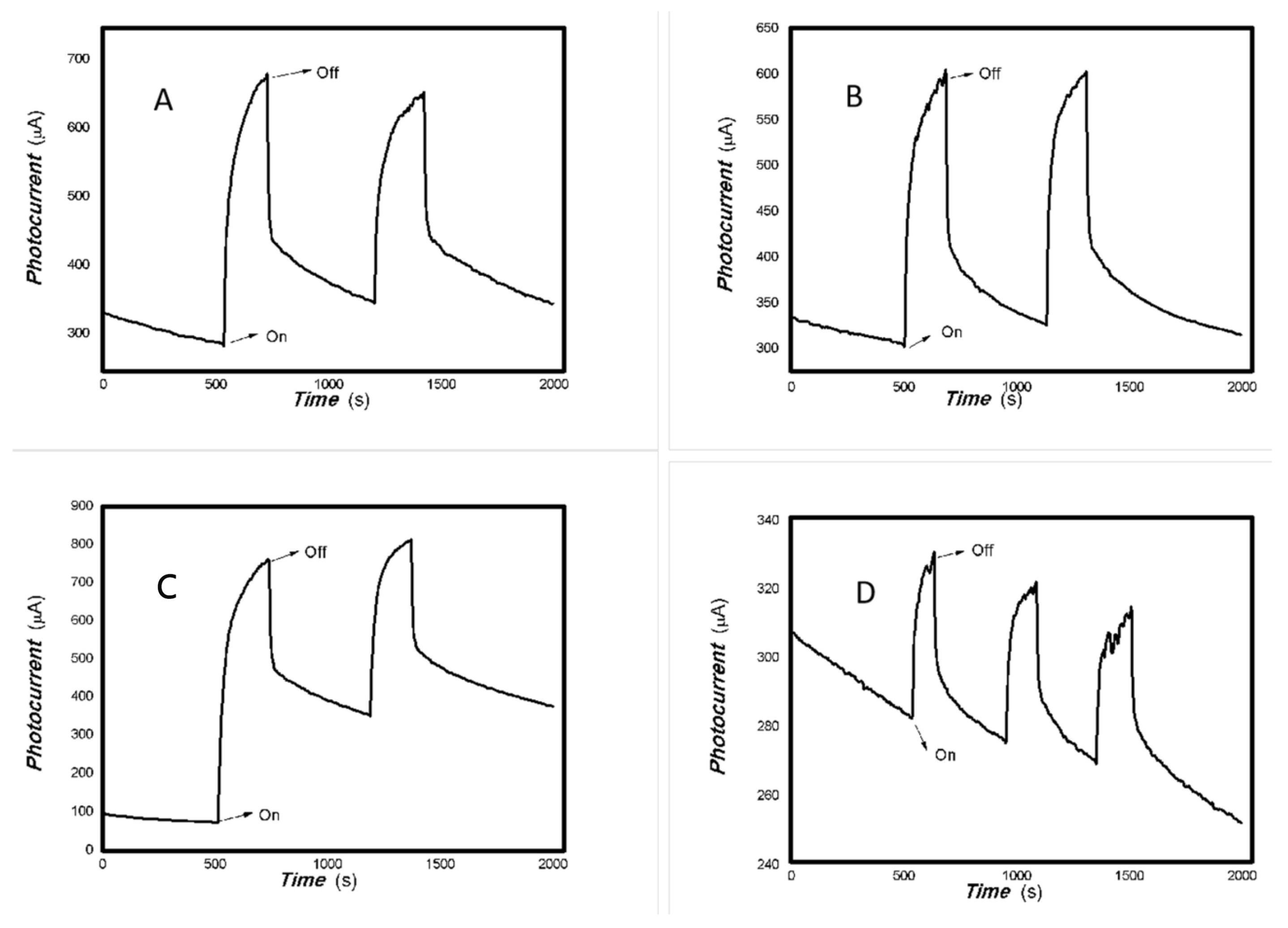
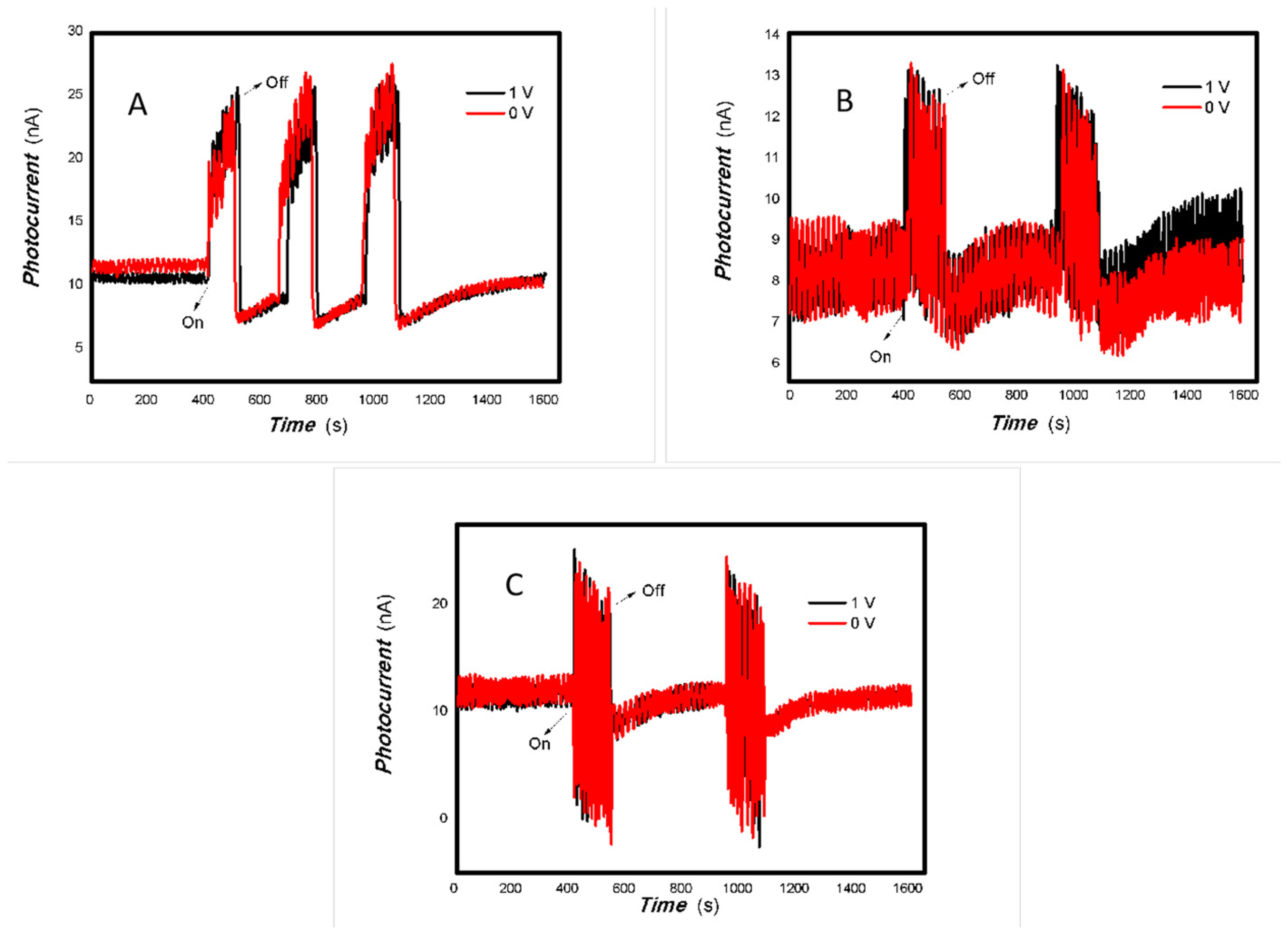
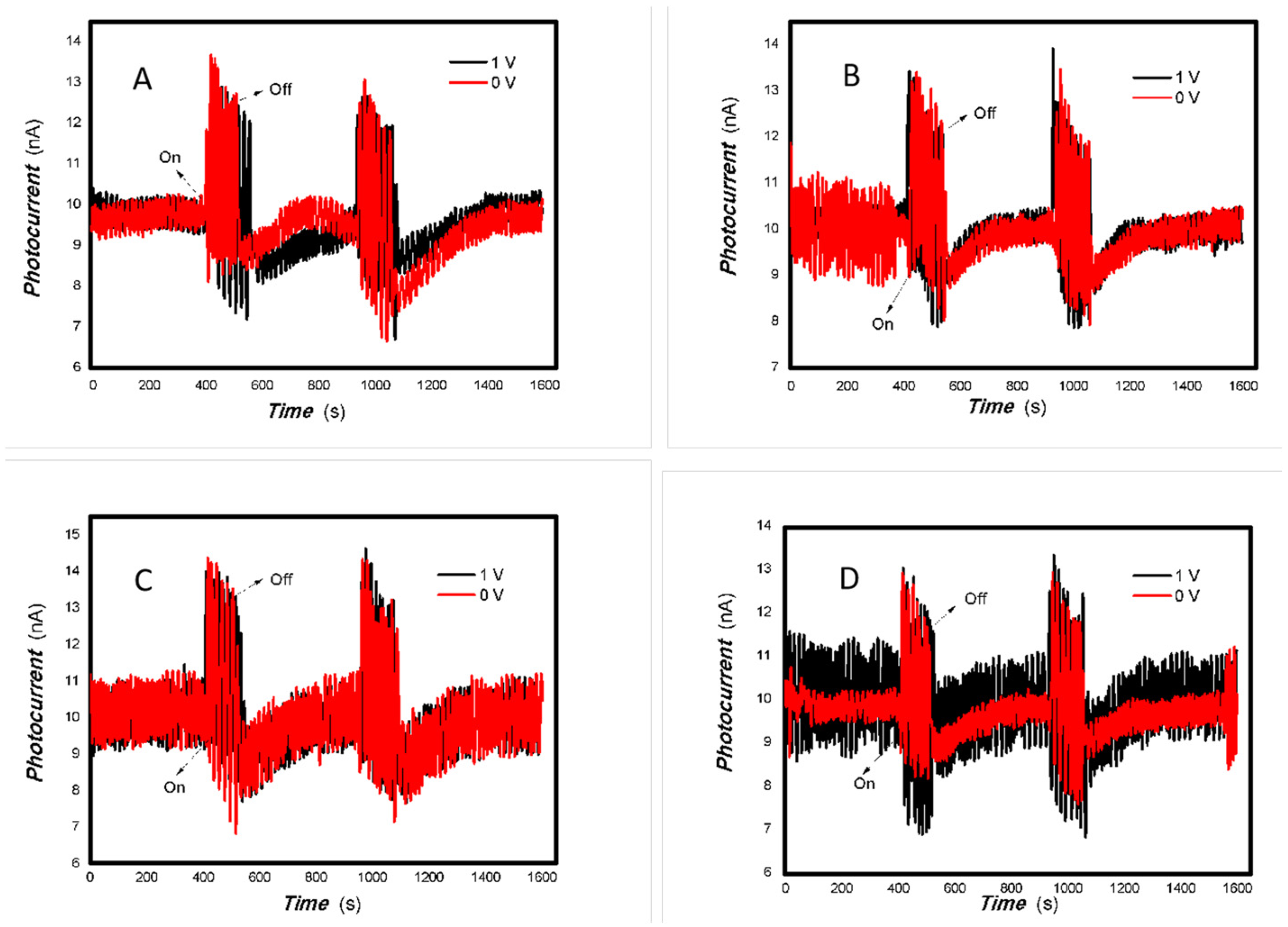


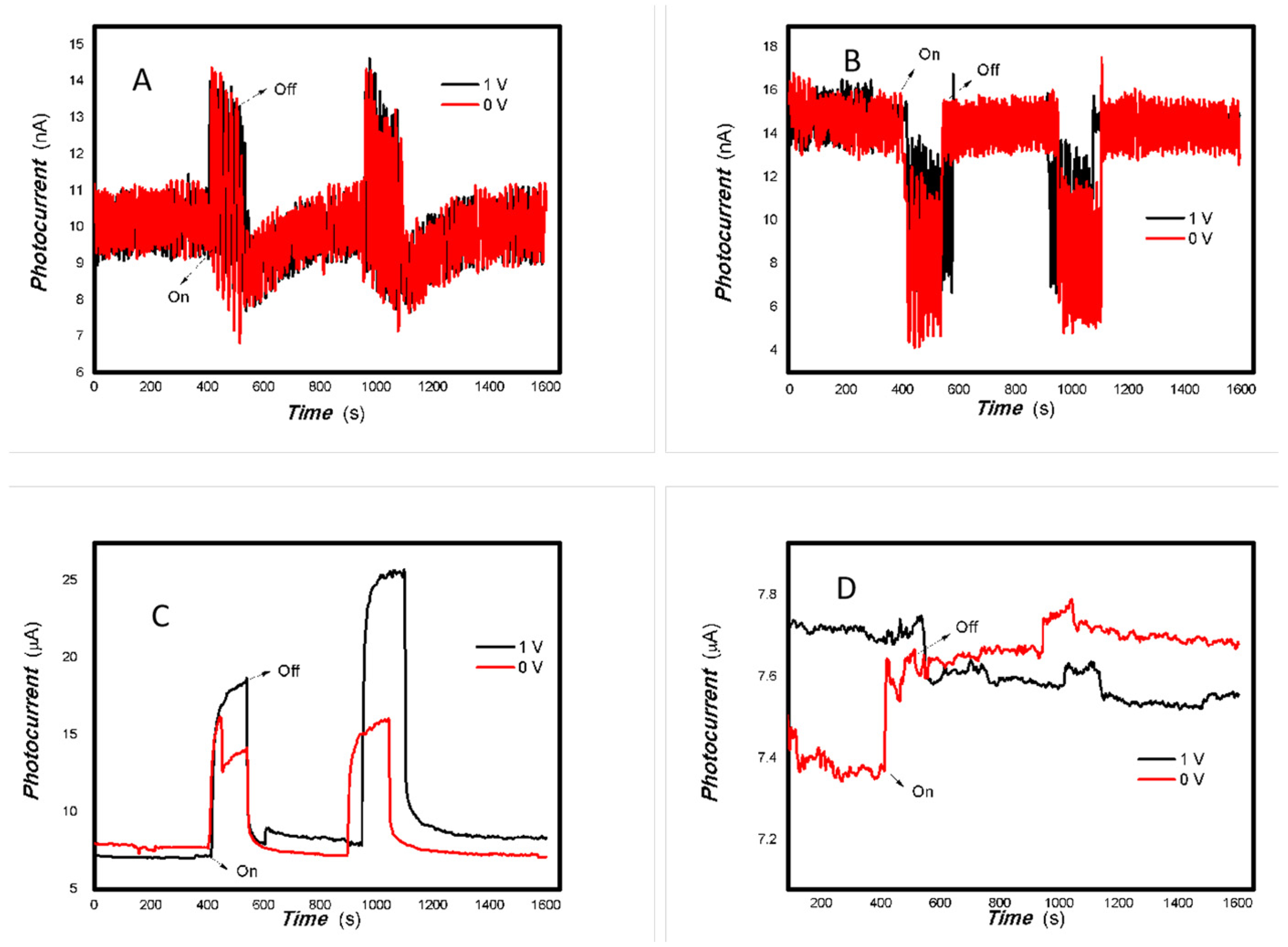
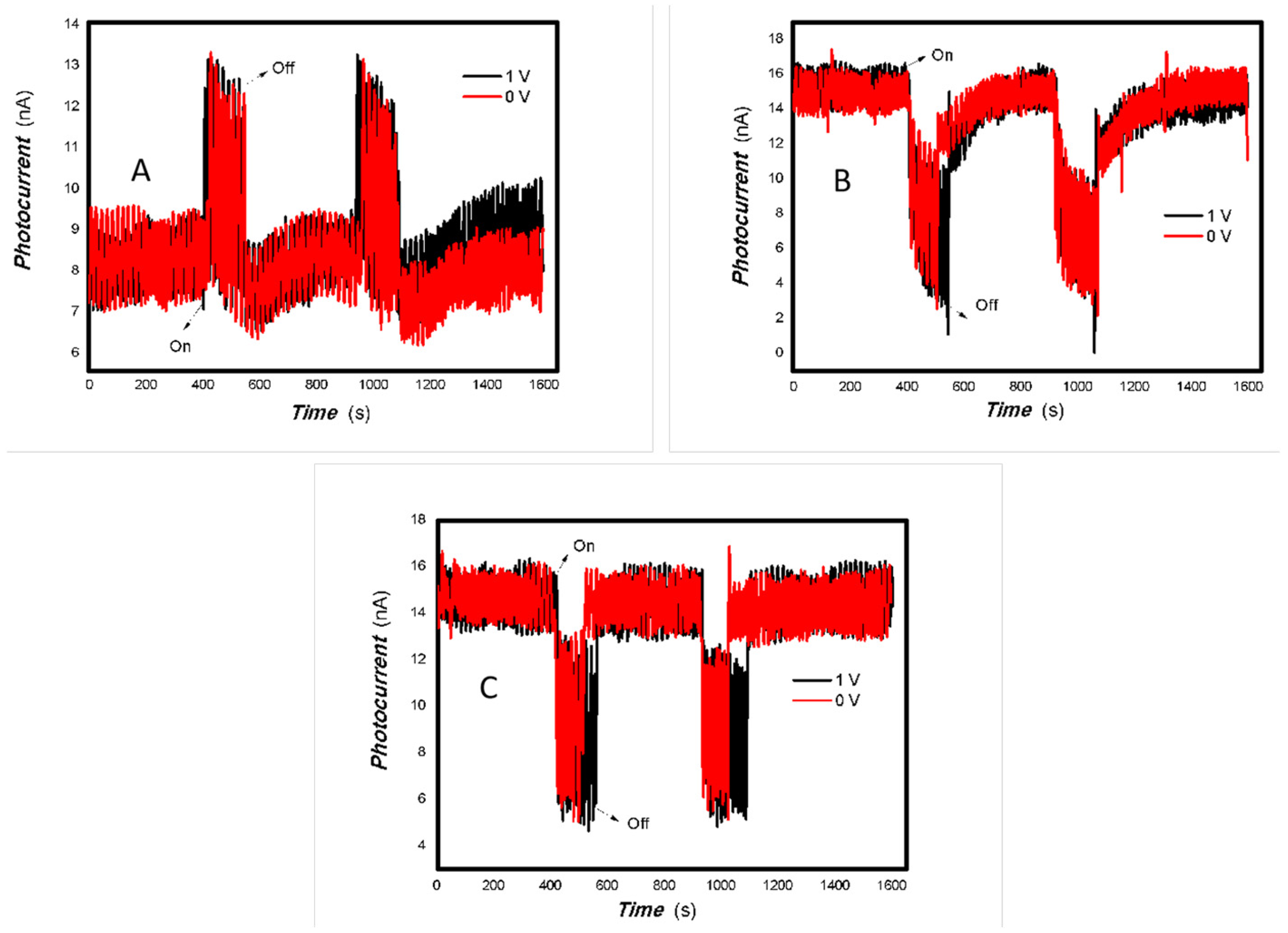
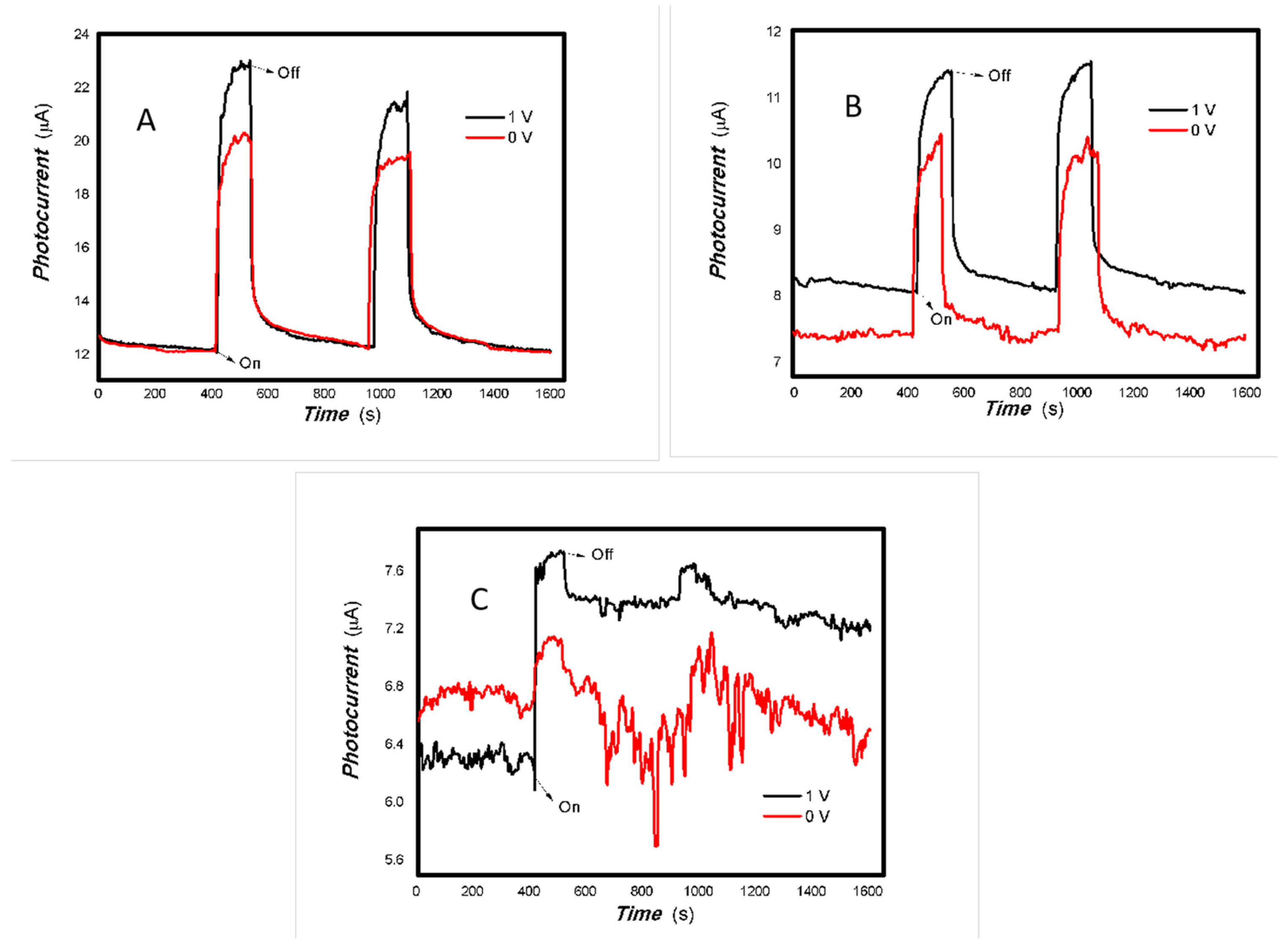
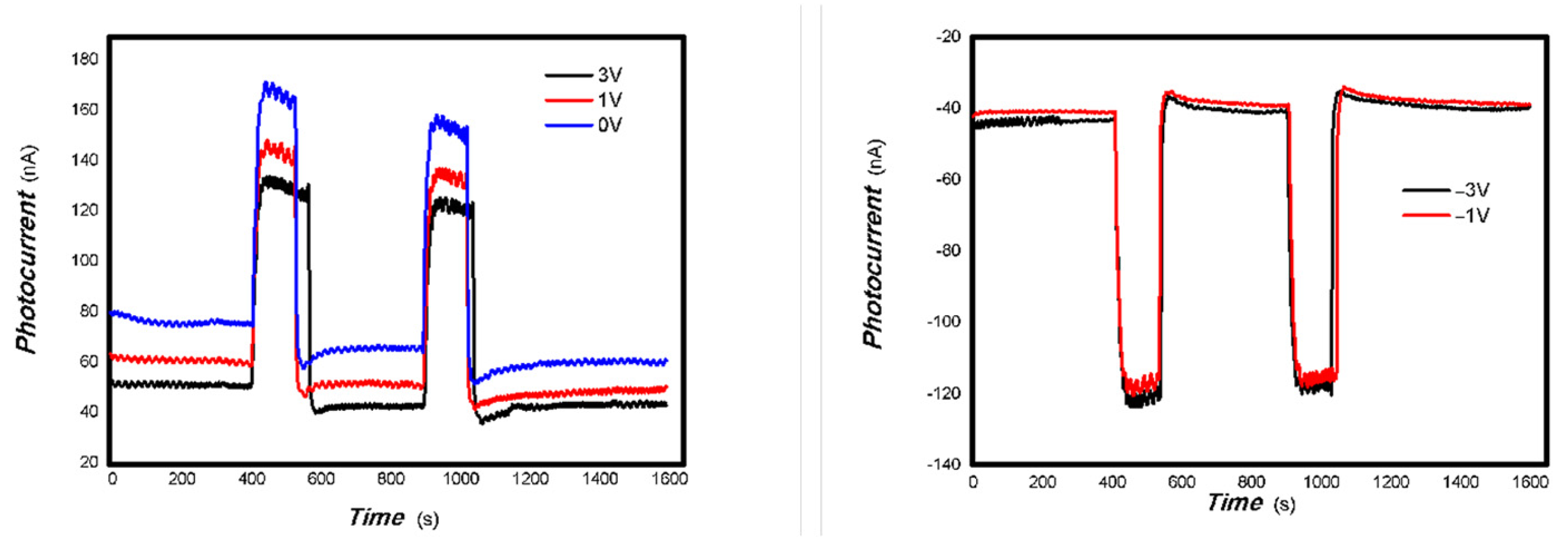
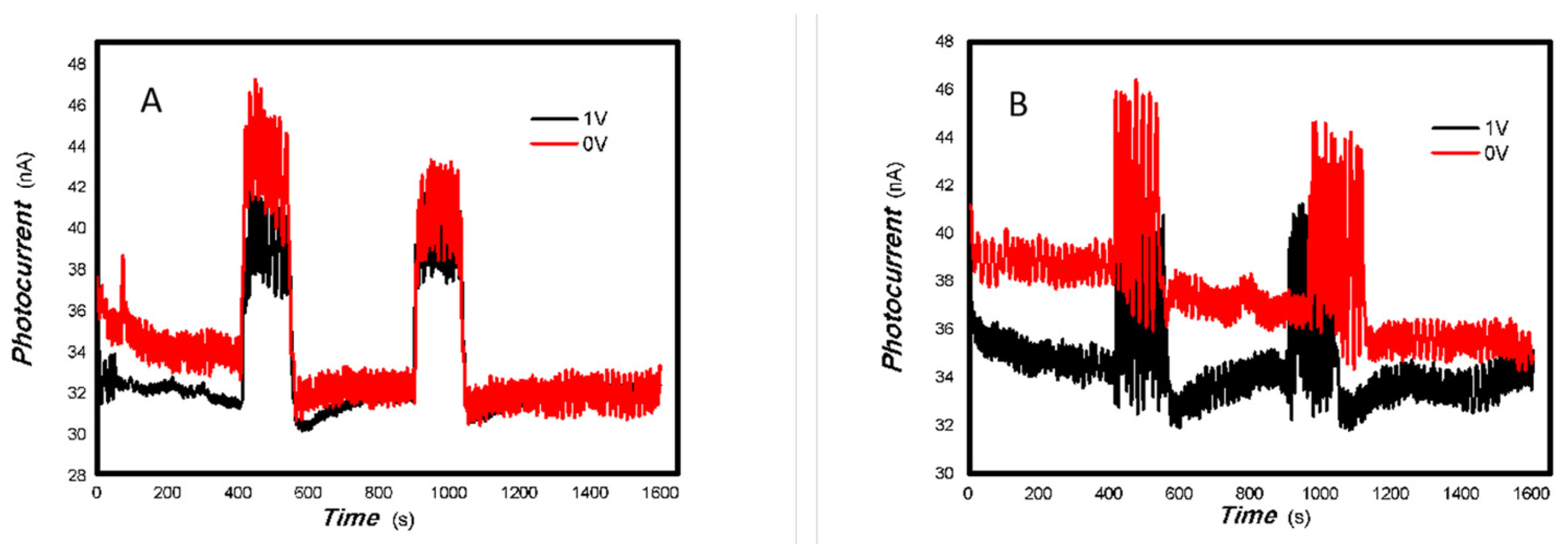


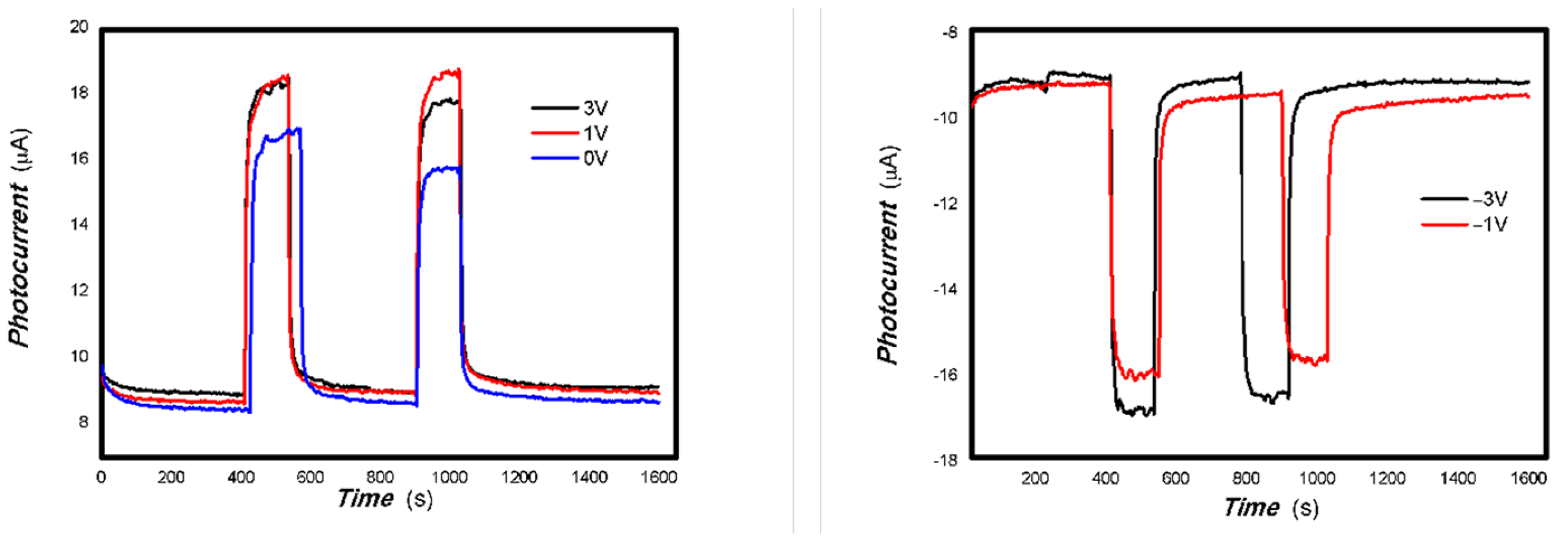
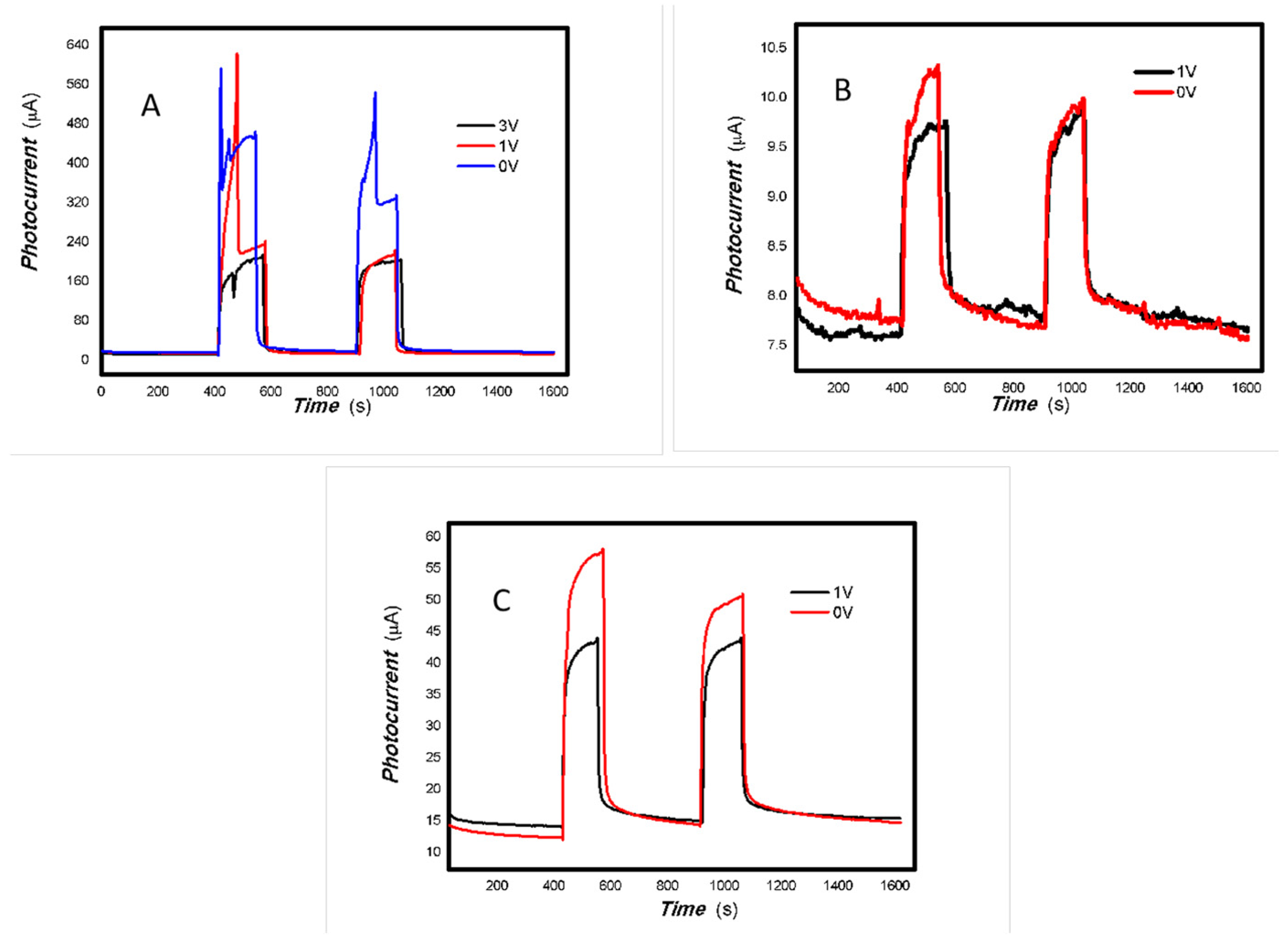

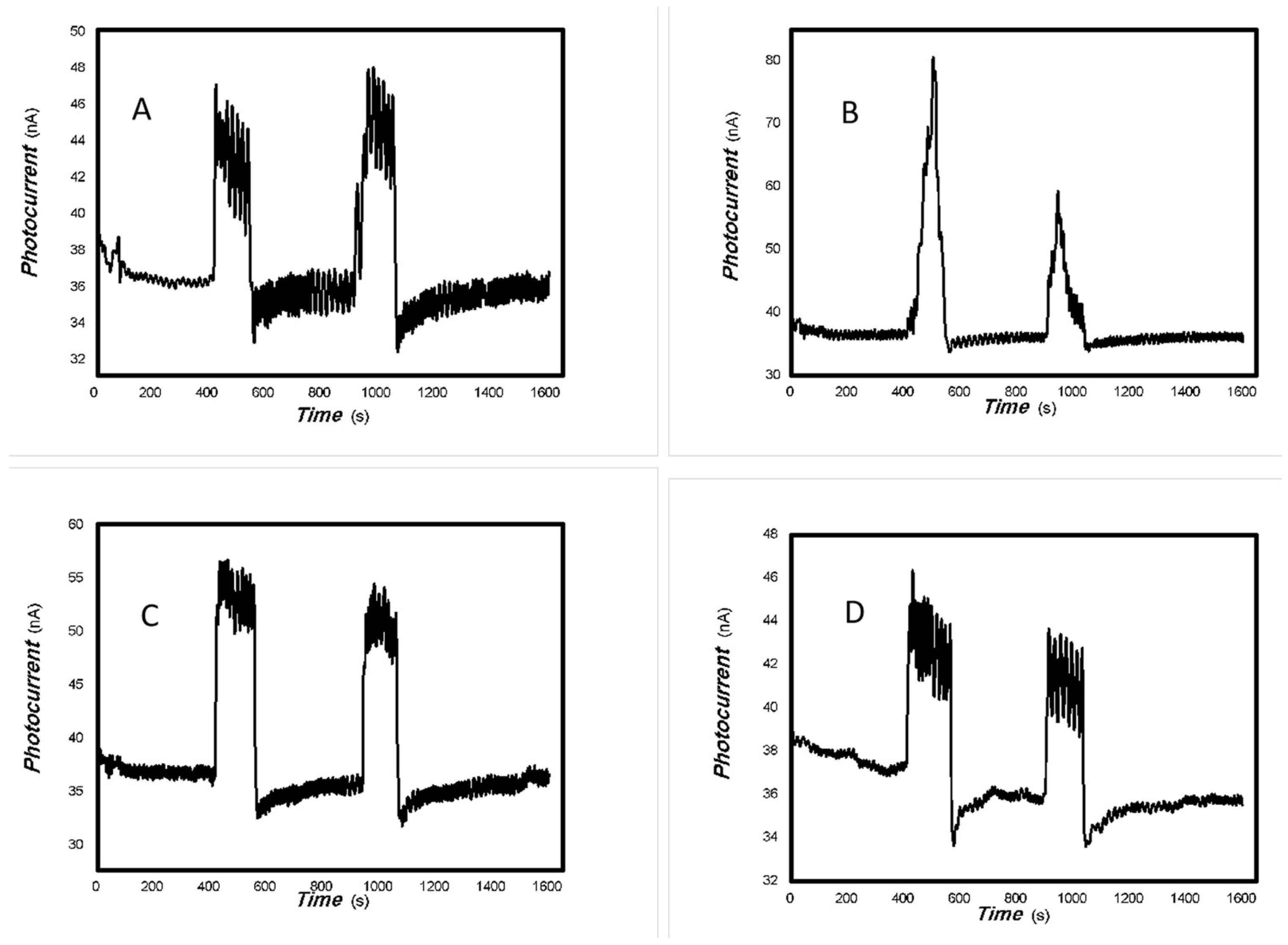
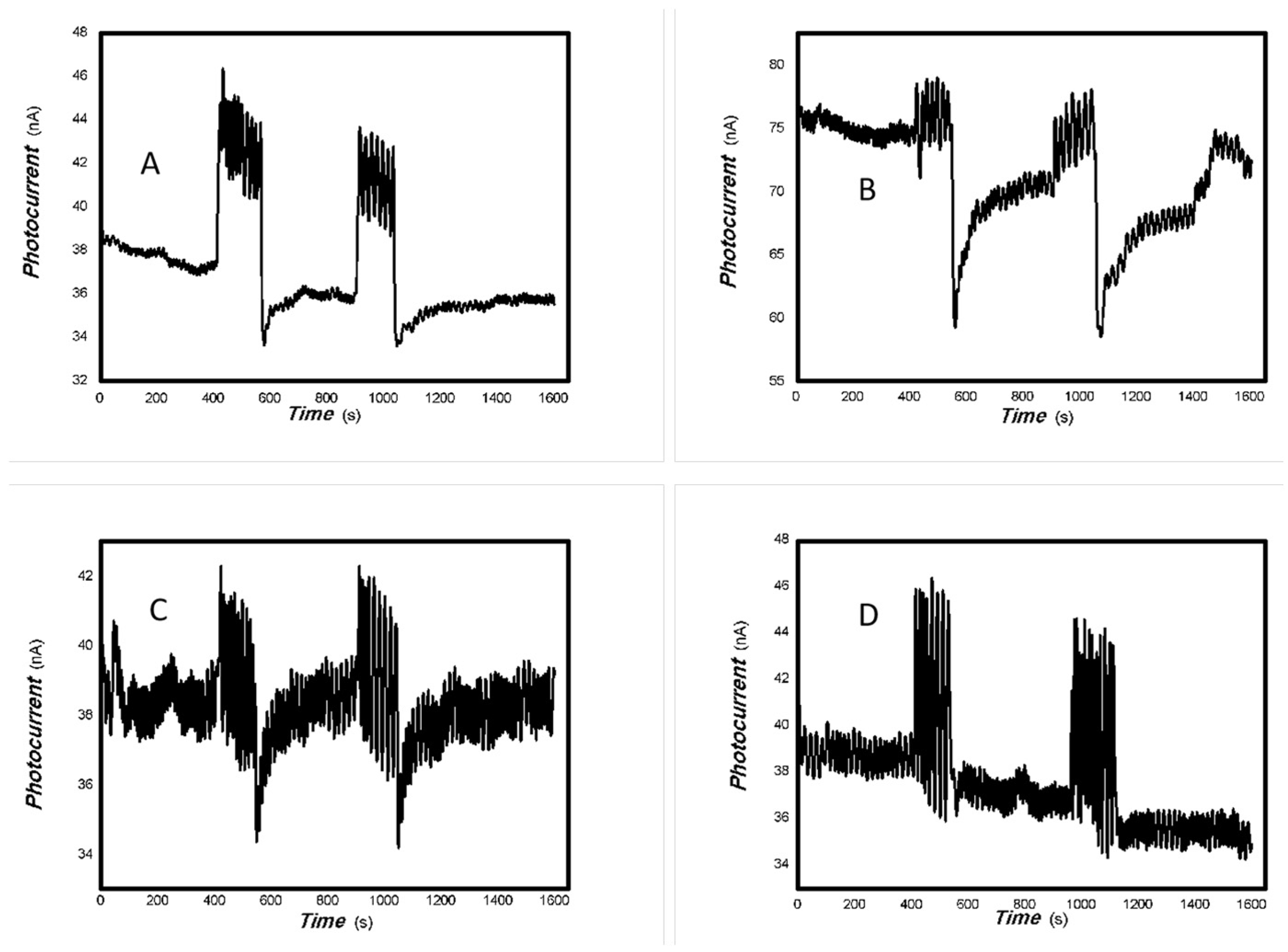
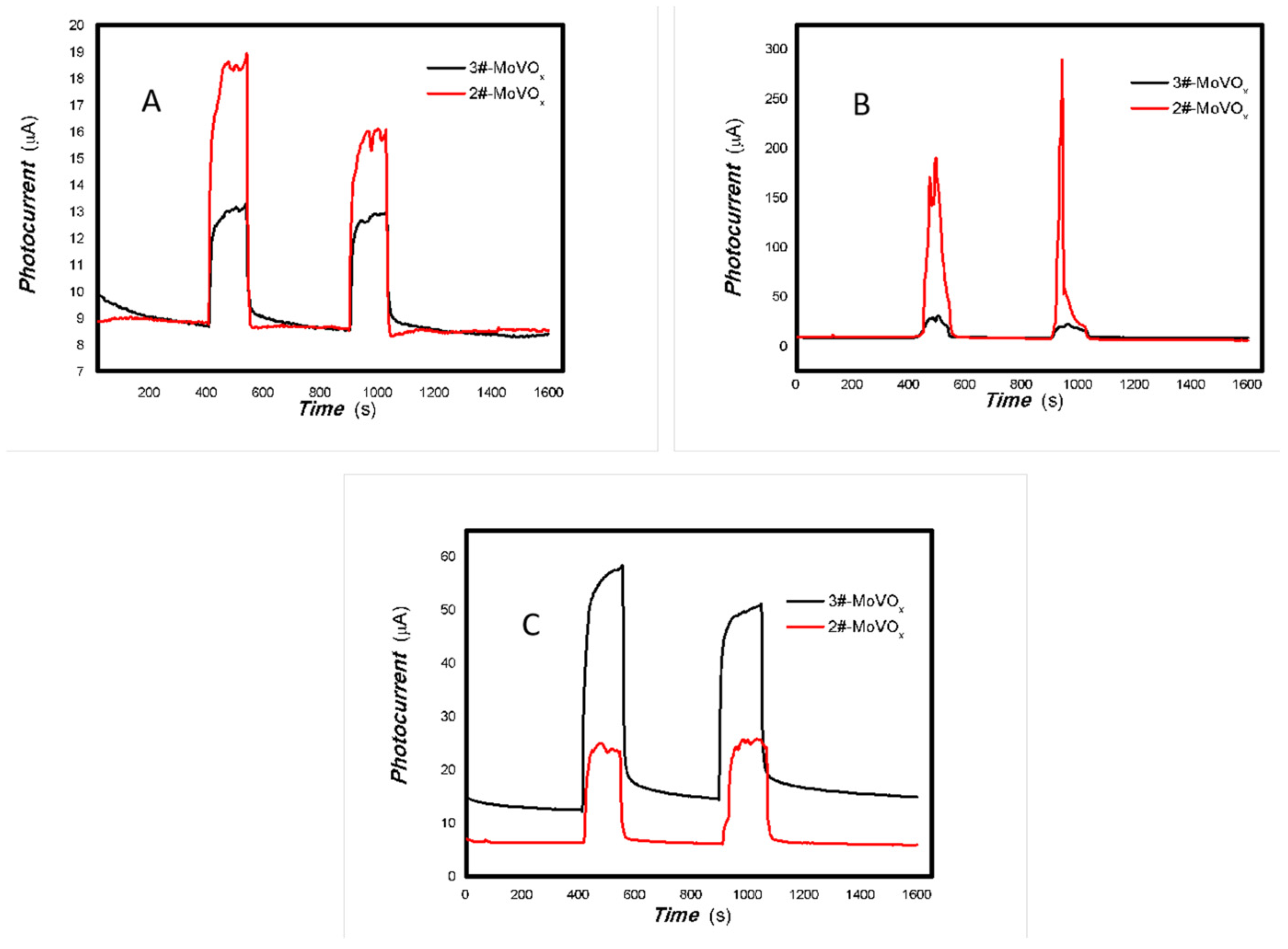
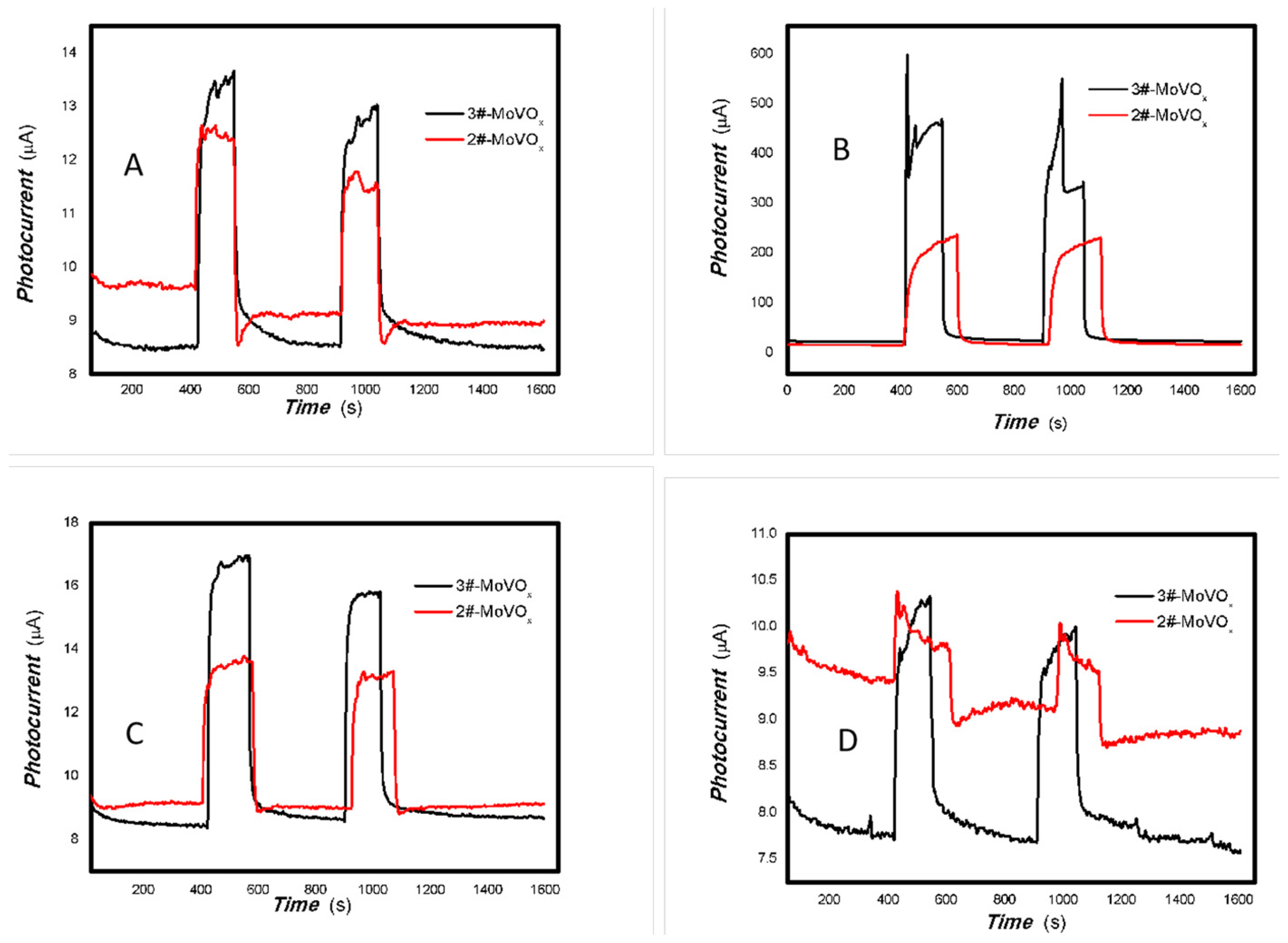
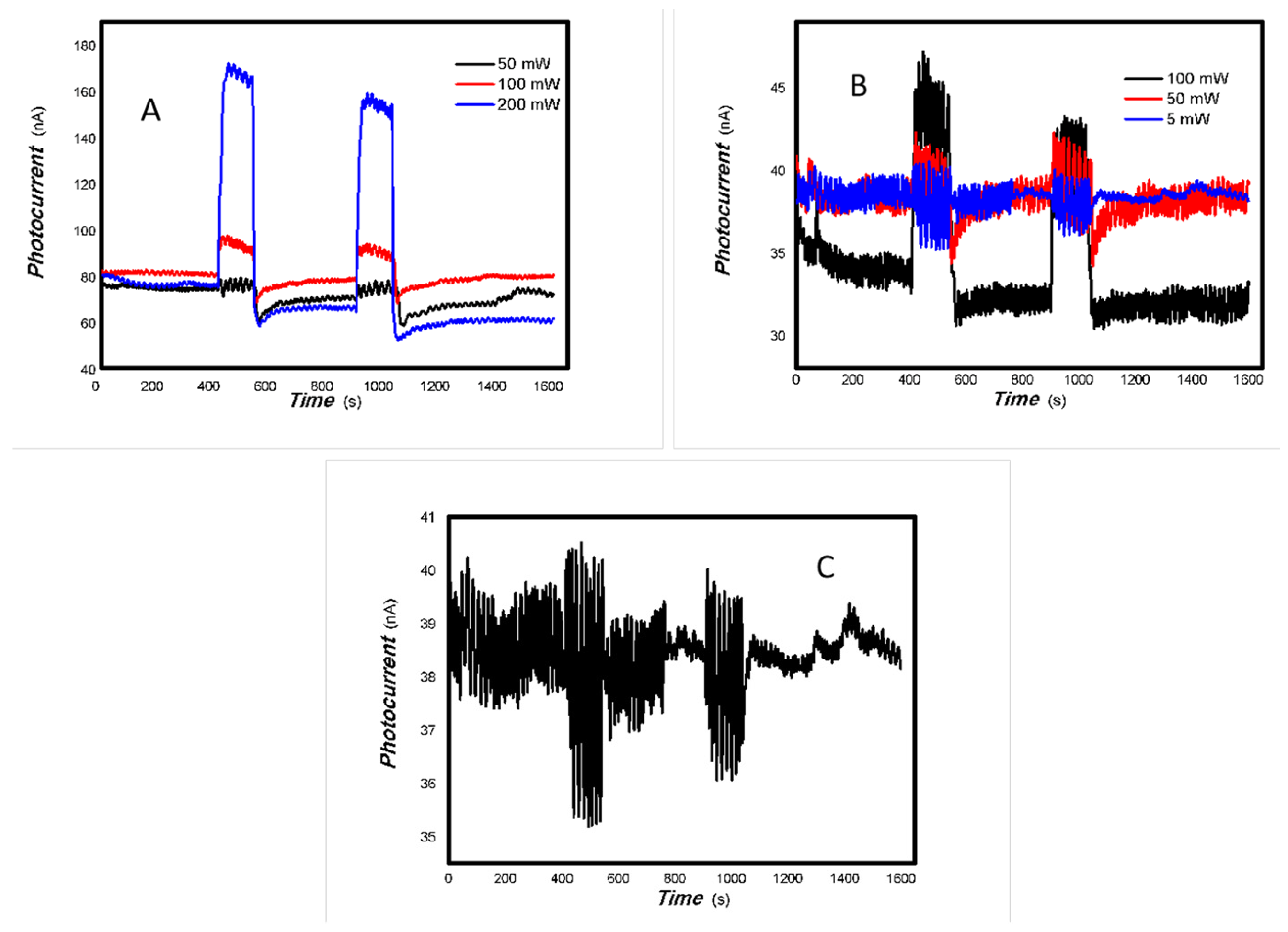
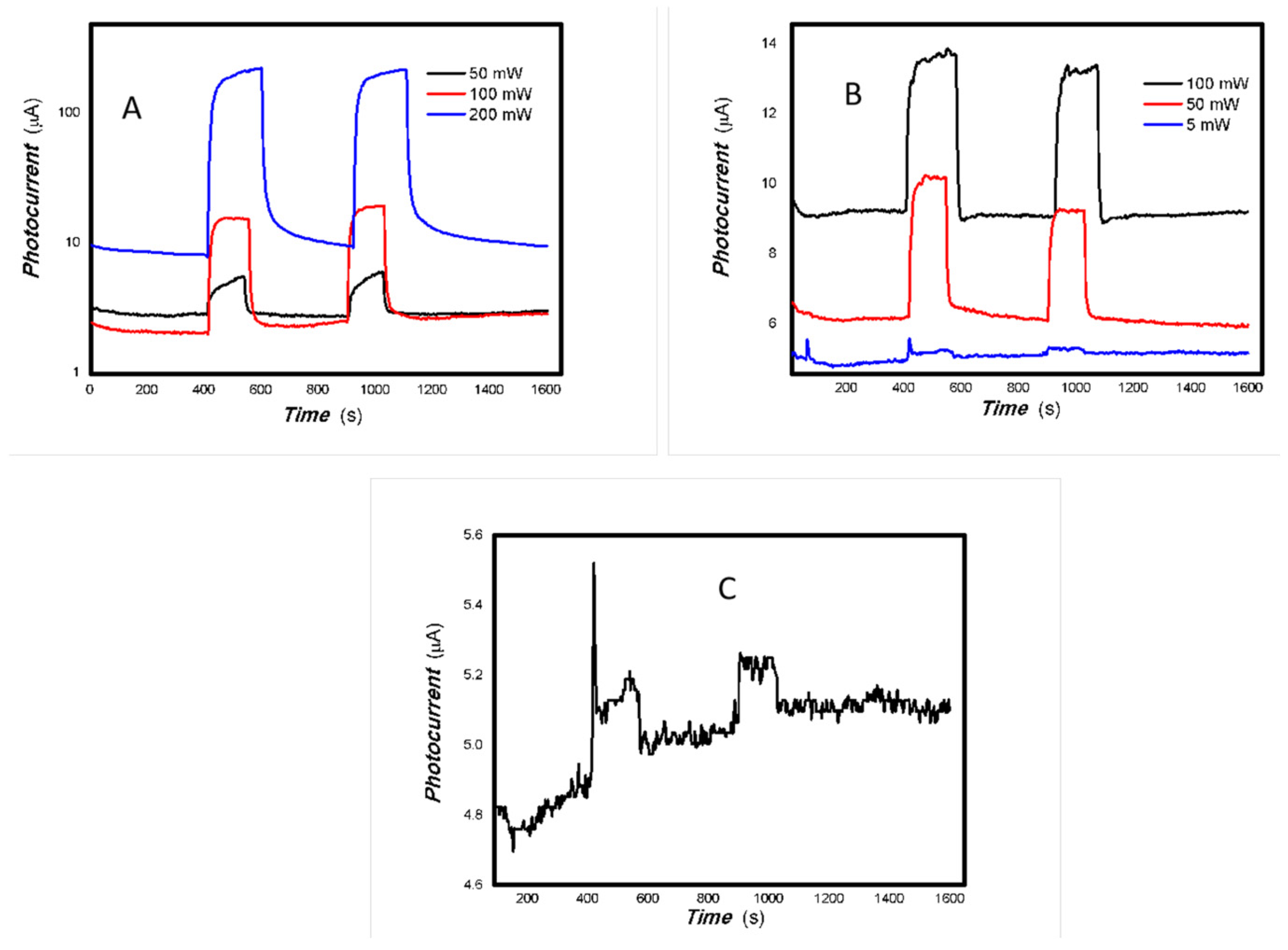
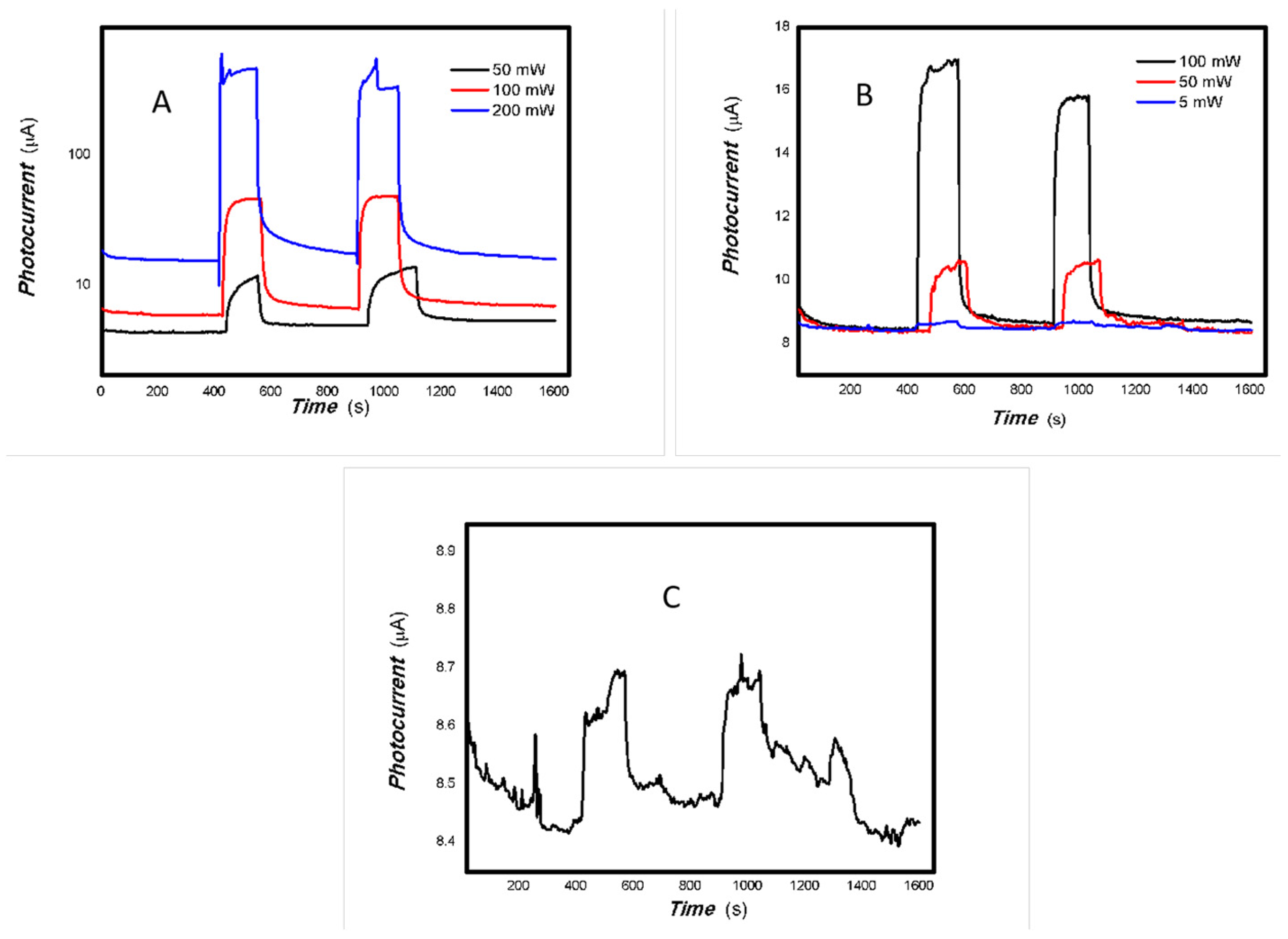

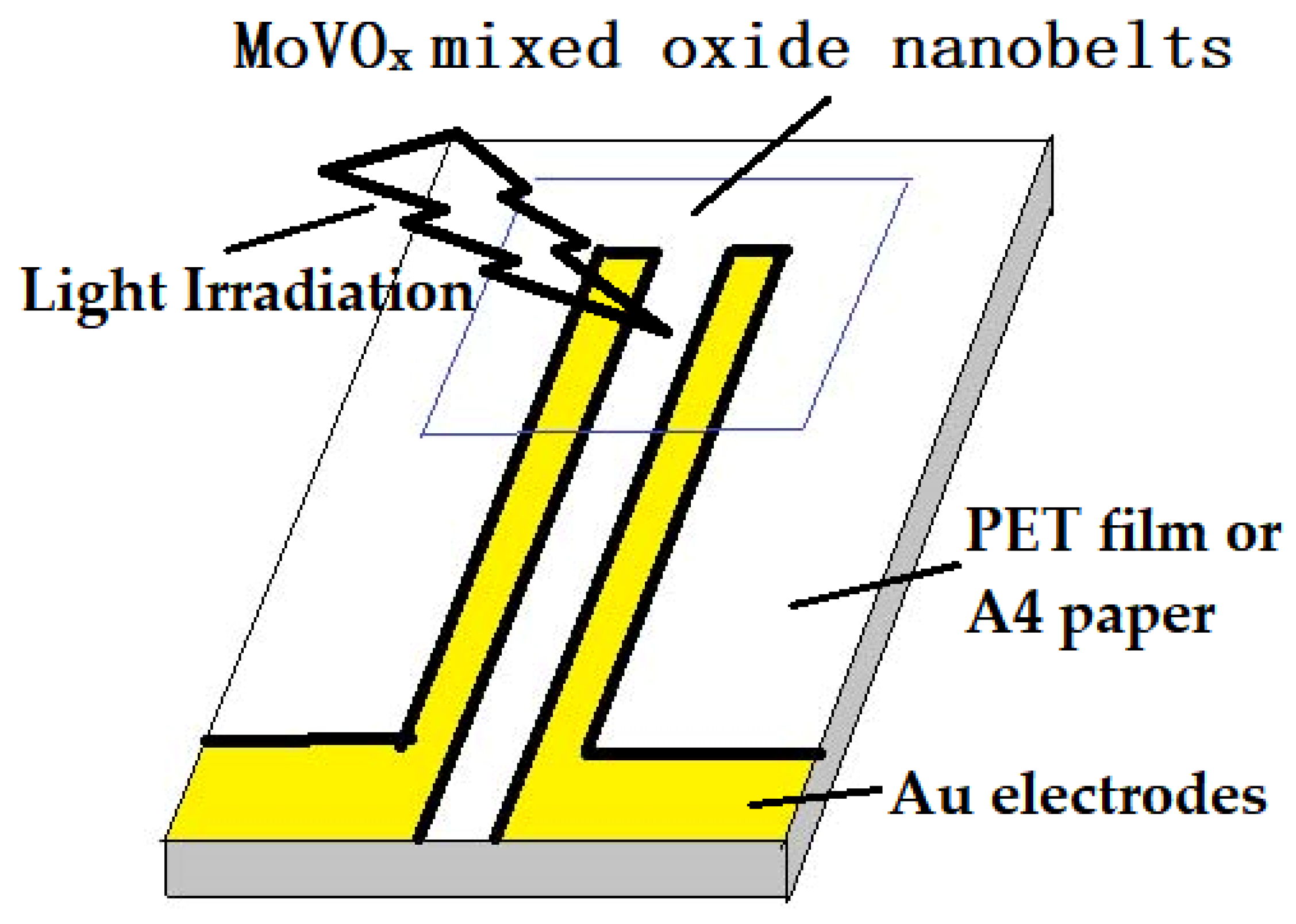
| Excitation Light Wavelength (nm) | Sample | Response Time (s) | Recovery Time (s) | Ratio of on/off |
|---|---|---|---|---|
| 100 mW, 650 nm | 1#-MoVOx | 36.8 | 12.0 | 5.74 |
| 100 mW, 650 nm | 2#-MoVOx | 48.9 | 24.0 | 19.68 |
| 100 mW, 650 nm | 3#-MoVOx | 65.1 | 106.3 | 2.28 |
| 200 mW, 808 nm | 1#-MoVOx | 48.8 | 28.3 | 3.85 |
| 200 mW, 808 nm | 2#-MoVOx | 41.1 | 20.6 | 7.81 |
| 200 mW, 808 nm | 3#-MoVOx | 57.4 | 143.1 | 1.89 |
| 200 mW, 980 nm | 1#-MoVOx | 32.6 | 32.6 | 1.84 |
| 200 mW, 980 nm | 2#-MoVOx | 64.8 | 50.2 | 93.28 |
| 100 mW, 980 nm | 2#-MoVOx | 7.7 | 20.6 | 2.01 |
| 200 mW, 980 nm | 3#-MoVOx | 106.3 | 138.8 | 9.80 |
| 20 mW, 1064 nm | 1#-MoVOx | 16.3 | 22.0 | 1.05 |
| 20 mW, 1064 nm | 2#-MoVOx | 4.3 | 12.0 | 1.63 |
| 20 mW, 1064 nm | 3#-MoVOx | 53.1 | 78.0 | 1.14 |
| Excitation Light Wavelength (nm) | Sample | Response Time (s) | Recovery Time (s) | Ratio of on/off |
|---|---|---|---|---|
| 50 mW, 405 nm | 1#-MoVOx | 11.7 | 7.9 | 1.30 |
| 50 mW, 405 nm | 3#-MoVOx | 39.7 | 55.6 | 2.02 |
| 50 mW, 532 nm | 1#-MoVOx | 3.8 | 19.6 | 1.26 |
| 50 mW, 532 nm | 3#-MoVOx | 39.7 | 39.7 | 1.62 |
| 50 mW, 650 nm | 1#-MoVOx | 7.94 | 31.8 | 1.34 |
| 50 mW, 650 nm | 3#-MoVOx | 28.0 | 43.5 | 1.78 |
| 5 mW, 650 nm | 1#-MoVOx | 12.1 | 15.9 | 3.10 *(negative photoconductivity) |
| 5 mW, 650 nm | 3#-MoVOx | 4.2 | 19.6 | 1.01 |
| 50 mW, 780 nm | 1#-MoVOx | 4.2 | 12.1 | 1.22 |
| 50 mW, 780 nm | 3#-MoVOx | 31.8 | 51.8 | 1.86 |
| 200 mW, 808 nm | 1#-MoVOx | 20.1 | 20.1 | 2.62 |
| 200 mW, 808 nm | 3#-MoVOx | 55.6 | 20.1 | 9.66 |
| 100 mW, 980 nm | 1#-MoVOx | 12.1 | 4.2 | 1.45 |
| 100 mW, 980 nm | 3#-MoVOx | 36.0 | 79.8 | 1.65 |
| 5 mW, 980 nm | 1#-MoVOx | 19.6 | 28.0 | 2.33 *(negative photoconductivity) |
| 5 mW, 980 nm | 3#-MoVOx | 47.6 | 43.9 | 1.06 |
| 20 mW, 1064 nm | 1#-MoVOx | 3.8 | 4.2 | 1.77 |
| 20 mW, 1064 nm | 3#-MoVOx | 19.6 | 47.6 | 1.37 |
| Excitation Light Wavelength (nm) | Sample | Response Time (s) | Recovery Time (s) | Ratio of on/off |
|---|---|---|---|---|
| 50 mW, 405 nm | 1#-MoVOx | 10.0 | 10.0 | 1.26 |
| 50 mW, 405 nm | 2#-MoVOx | 43.47 | 12.1 | 2.09 |
| 50 mW, 405 nm | 3#-MoVOx | 28.0 | 35.9 | 1.49 |
| 50 mW, 532 nm | 1#-MoVOx | 65.5 | 13.1 | 1.46 |
| 50 mW, 532 nm | 2#-MoVOx | 19.6 | 47.6 | 18.64 |
| 50 mW, 532 nm | 3#-MoVOx | 59.4 | 36.0 | 3.32 |
| 50 mW, 650 nm | 1#-MoVOx | 6.6 | 13.4 | 1.51 |
| 50 mW, 650 nm | 2#-MoVOx | 27.6 | 28.0 | 3.71 |
| 50 mW, 650 nm | 3#-MoVOx | 23.8 | 31.8 | 4.60 |
| 50 mW, 780 nm | 1#-MoVOx | 13.1 | 6.6 | 1.19 |
| 50 mW, 780 nm | 2#-MoVOx | 20.1 | 7.9 | 1.30 |
| 50 mW, 780 nm | 3#-MoVOx | 35.5 | 59.8 | 1.58 |
| 50 mW, 808 nm | 1#-MoVOx | 3.4 | 13.1 | 1.05 |
| 50 mW, 808 nm | 2#-MoVOx | 55.6 | 28.0 | 1.94 |
| 50 mW, 808 nm | 3#-MoVOx | 63.5 | 43.9 | 2.68 |
| 50 mW, 980 nm | 1#-MoVOx | 13.1 | 13.1 | 1.07 |
| 50 mW, 980 nm | 2#-MoVOx | 23.8 | 28.0 | 1.66 |
| 50 mW, 980 nm | 3#-MoVOx | 32.2 | 83.6 | 1.25 |
| 5 mW, 980 nm | 1#-MoVOx | 6.6 | 10.0 | 1.04 |
| 5 mW, 980 nm | 2#-MoVOx | 18.6 | 12.4 | 1.05 |
| 5 mW, 980 nm | 3#-MoVOx | 19.5 | 19.5 | 1.02 |
| 20 mW, 1064 nm | 1#-MoVOx | 6.6 | 16.2 | 1.18 |
| 20 mW, 1064 nm | 2#-MoVOx | 7.9 | 11.7 | 1.05 |
| 20 mW, 1064 nm | 3#-MoVOx | 20.1 | 56.0 | 1.32 |
Disclaimer/Publisher’s Note: The statements, opinions and data contained in all publications are solely those of the individual author(s) and contributor(s) and not of MDPI and/or the editor(s). MDPI and/or the editor(s) disclaim responsibility for any injury to people or property resulting from any ideas, methods, instructions or products referred to in the content. |
© 2025 by the authors. Licensee MDPI, Basel, Switzerland. This article is an open access article distributed under the terms and conditions of the Creative Commons Attribution (CC BY) license (https://creativecommons.org/licenses/by/4.0/).
Share and Cite
Ma, X.; Zhang, X.; Gao, M.; Hu, R.; Wang, Y.; Li, G. One-Pot Synthesis of the MoVOx Mixed Oxide Nanobelts and Its Photoelectric Properties in the Broadband Light Spectrum Range Exhibiting Self-Powered Characteristics. Inorganics 2025, 13, 273. https://doi.org/10.3390/inorganics13080273
Ma X, Zhang X, Gao M, Hu R, Wang Y, Li G. One-Pot Synthesis of the MoVOx Mixed Oxide Nanobelts and Its Photoelectric Properties in the Broadband Light Spectrum Range Exhibiting Self-Powered Characteristics. Inorganics. 2025; 13(8):273. https://doi.org/10.3390/inorganics13080273
Chicago/Turabian StyleMa, Xingfa, Xintao Zhang, Mingjun Gao, Ruifen Hu, You Wang, and Guang Li. 2025. "One-Pot Synthesis of the MoVOx Mixed Oxide Nanobelts and Its Photoelectric Properties in the Broadband Light Spectrum Range Exhibiting Self-Powered Characteristics" Inorganics 13, no. 8: 273. https://doi.org/10.3390/inorganics13080273
APA StyleMa, X., Zhang, X., Gao, M., Hu, R., Wang, Y., & Li, G. (2025). One-Pot Synthesis of the MoVOx Mixed Oxide Nanobelts and Its Photoelectric Properties in the Broadband Light Spectrum Range Exhibiting Self-Powered Characteristics. Inorganics, 13(8), 273. https://doi.org/10.3390/inorganics13080273



_Ma.jpg)



